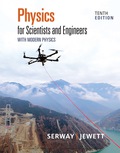
(a)
The wavelength of the wave.
(a)
Answer to Problem 51CP
The wavelength of the wave is
Explanation of Solution
Given info: The frequency of the wave is
The formula to calculate the wavelength is,
Here,
Substitute
Conclusion:
Therefore, the wavelength of the wave is
(b)
The time period of the wave.
(b)
Answer to Problem 51CP
The time period of the wave is
Explanation of Solution
Given info: The frequency of the wave is
The formula to calculate the time period is,
Substitute
Conclusion:
Therefore, the time period of the wave is
(c)
The maximum value of the magnetic field.
(c)
Answer to Problem 51CP
The maximum value of the magnetic field is
Explanation of Solution
Given info: The frequency of the wave is
The formula to calculate the magnitude of the magnetic field is,
Here,
Substitute
Conclusion:
Therefore, the maximum value of the magnetic field is
(d)
The expression for electric field and the magnetic field.
(d)
Answer to Problem 51CP
The expression for electric field is
Explanation of Solution
Given info: The frequency of the wave is
The formula to calculate the angular frequency is,
Here,
Substitute the
The formula to calculate the angular constant is,
Here,
Substitute the
The formula to calculate the electric field is,
Substitute
The electric field is in the same direction of wave propagation.
The formula to calculate the magnetic field is,
Substitute
The direction of propagation of the magnetic field is perpendicular to that of the electric field.
Conclusion:
Therefore, the expression for electric field is
(e)
The average power per unit area the wave carries.
(e)
Answer to Problem 51CP
The average power per unit area the wave carries is
Explanation of Solution
Given info: The frequency of the wave is
The formula to calculate the average power per unit area is,
Here,
Substitute
Conclusion:
Therefore, the average power per unit area the wave carries is
(f)
The average energy density in the
(f)
Answer to Problem 51CP
The average energy density in the radiation is
Explanation of Solution
Given info: The frequency of the wave is
The formula to calculate the average energy density is,
Substitute
Conclusion:
Therefore, the average energy density in the radiation is
(g)
The radiation pressure exerted by the wave.
(g)
Answer to Problem 51CP
The radiation pressure exerted by the wave is
Explanation of Solution
Given info: The frequency of the wave is
The formula to calculate the radiation pressure is,
Substitute
Conclusion:
Therefore, the radiation pressure exerted by the wave is
Want to see more full solutions like this?
Chapter 33 Solutions
Physics for Scientists and Engineers with Modern Physics
- What is the direction of the magnetic force on a NEGATIVE CHARGE that moves as shown in each of the six cases?arrow_forwardHi! I need help with these calculations for part i and part k for a physics Diffraction Lab. We used a slit width 0.4 mm to measure our pattern.arrow_forwardExamine the data and % error values in Data Table 3 where the angular displacement of the simple pendulum decreased but the mass of the pendulum bob and the length of the pendulum remained constant. Describe whether or not your data shows that the period of the pendulum depends on the angular displacement of the pendulum bob, to within a reasonable percent error.arrow_forward
- In addition to the anyalysis of the graph, show mathematically that the slope of that line is 2π/√g . Using the slope of your line calculate the value of g and compare it to 9.8.arrow_forwardAn object is placed 24.1 cm to the left of a diverging lens (f = -6.51 cm). A concave mirror (f= 14.8 cm) is placed 30.2 cm to the right of the lens to form an image of the first image formed by the lens. Find the final image distance, measured relative to the mirror. (b) Is the final image real or virtual? (c) Is the final image upright or inverted with respect to the original object?arrow_forwardConcept Simulation 26.4 provides the option of exploring the ray diagram that applies to this problem. The distance between an object and its image formed by a diverging lens is 5.90 cm. The focal length of the lens is -2.60 cm. Find (a) the image distance and (b) the object distance.arrow_forward
 Physics for Scientists and Engineers: Foundations...PhysicsISBN:9781133939146Author:Katz, Debora M.Publisher:Cengage Learning
Physics for Scientists and Engineers: Foundations...PhysicsISBN:9781133939146Author:Katz, Debora M.Publisher:Cengage Learning
 Principles of Physics: A Calculus-Based TextPhysicsISBN:9781133104261Author:Raymond A. Serway, John W. JewettPublisher:Cengage Learning
Principles of Physics: A Calculus-Based TextPhysicsISBN:9781133104261Author:Raymond A. Serway, John W. JewettPublisher:Cengage Learning Physics for Scientists and Engineers, Technology ...PhysicsISBN:9781305116399Author:Raymond A. Serway, John W. JewettPublisher:Cengage Learning
Physics for Scientists and Engineers, Technology ...PhysicsISBN:9781305116399Author:Raymond A. Serway, John W. JewettPublisher:Cengage Learning Physics for Scientists and EngineersPhysicsISBN:9781337553278Author:Raymond A. Serway, John W. JewettPublisher:Cengage Learning
Physics for Scientists and EngineersPhysicsISBN:9781337553278Author:Raymond A. Serway, John W. JewettPublisher:Cengage Learning Physics for Scientists and Engineers with Modern ...PhysicsISBN:9781337553292Author:Raymond A. Serway, John W. JewettPublisher:Cengage Learning
Physics for Scientists and Engineers with Modern ...PhysicsISBN:9781337553292Author:Raymond A. Serway, John W. JewettPublisher:Cengage Learning





